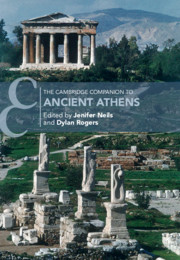Book contents
- The Cambridge Companion to Ancient Athens
- Cambridge Companions to the Ancient World
- The Cambridge Companion to Ancient Athens
- Copyright page
- Contents
- Contributors
- Abbreviations
- Athens: An Introduction
- 1 #Leagros: An Athenian Life
- Part I The Urban Fabric
- Part II Inhabitants
- Part III Business/Commerce
- 15 Labor and Employment
- 16 Piraeus: Harbors, Navy, and Shipping
- 17 The Archaeology of Markets and Trade
- 18 Coinage and Its Economic Implications
- 19 The Ceramic Industry
- 20 Sculpture and Its Role in the City
- Part IV Culture and Sport
- Part V Politics
- Reception
- Index
- References
15 - Labor and Employment
from Part III - Business/Commerce
Published online by Cambridge University Press: 10 March 2021
- The Cambridge Companion to Ancient Athens
- Cambridge Companions to the Ancient World
- The Cambridge Companion to Ancient Athens
- Copyright page
- Contents
- Contributors
- Abbreviations
- Athens: An Introduction
- 1 #Leagros: An Athenian Life
- Part I The Urban Fabric
- Part II Inhabitants
- Part III Business/Commerce
- 15 Labor and Employment
- 16 Piraeus: Harbors, Navy, and Shipping
- 17 The Archaeology of Markets and Trade
- 18 Coinage and Its Economic Implications
- 19 The Ceramic Industry
- 20 Sculpture and Its Role in the City
- Part IV Culture and Sport
- Part V Politics
- Reception
- Index
- References
Summary
This chapter studies working life at Athens, sketching the range of occupations in the Athenian economy, from farming in the countryside to artisans, vendors, and purveyors of services in the city.
- Type
- Chapter
- Information
- The Cambridge Companion to Ancient Athens , pp. 217 - 230Publisher: Cambridge University PressPrint publication year: 2021
References
Further Reading
Much has changed in the last two decades regarding general views of the ancient Greek economy; a splendid, detailed, and up-to-date vade mecum is Bresson 2016. On the range of occupations in Attika, see Harris 2002, with supplements in Lewis 2020. Taylor 2017 provides an overview of the working population of Athens’ living standards; Lewis 2018, 167–193 discusses the slave population, whilst Brock 1994 discusses the labor of women. Spantidaki 2016 provides a wide-ranging study of textile production. Hasaki 2012 is a useful entry-point to the study of the crafts of potter, smith, and mason, while Sanidas 2013 provides a catalogue of excavated workshops. On masons, Hochscheid 2015 is fundamental. See Vidale 2002 for a detailed study (with many images) of the iconography of artisans, along with Oakley 2020, 47–70 for depictions of workshops on Athenian vases. Acton 2014 contains useful discussion of manufacture but should be used with caution (see the useful review of Rotroff in the Bryn Mawr Classical Review 2015.04.23).

